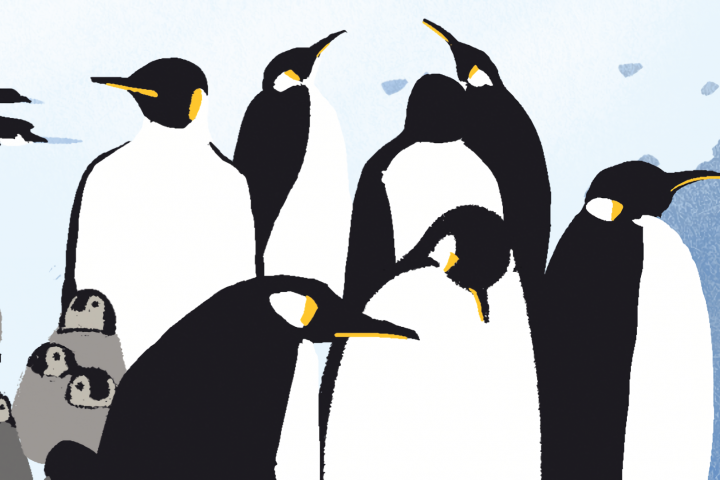From the Sky to the Sea: The Evolution of Penguins
By Kit Kan 簡迎曦

When we think of birds, we often picture creatures that fly freely in the sky with their big strong wings. Some scientists believe that the last common ancestor of all living birds could fly [1], but many species have lost this ability during the course of evolution. Penguins, emus, ostriches and some species of ducks have all lost this ability. It is not difficult to imagine the benefits brought by flight. Being able to travel long distances and escape from predators make flying a valuable skill. So why did these birds lose their ability to fly? What have they gained from not flying? Why do they still have wings? We will answer all these questions using penguin as an example.
One simple explanation of why penguins gave up flying is the high energy cost of flight. A study on the two living birds that could both fly and dive showed that it is difficult to optimize wings for both flying and diving [2]. For wing-propelled diving, birds need a large body size and short flat wings with dense bones. However, for flying, they need a smaller body with larger wings to lift themselves off the ground. Since these features are exact opposites of each other, if a bird is to use its wings to propel through water to find food, it is unlikely that their wings are also optimized for flying, leading to a high energy cost.
Another dimension to the flightlessness of penguins has to do with ecology. According to genetic analyses, penguins’ closest living relatives are the Procellariiformes, an order of birds that can all fly (footnote 1). The divergence of these two groups of birds are thought to have happened around 66 million years ago, at the end of the Cretaceous period [3], when an asteroid wiped out three-quarters of plant and animal species on Earth, including many marine predators [4, 5], opening the ecological niches in the ocean. In the absence of large marine animals, escaping from marine predators became less of a problem for the ancestors of penguins. Without the competition for food in the sea, travelling long distance for food was also unnecessary. Suddenly diving, which uses less energy and provides more food, became more desirable than flying.
Once penguin ancestors started underwater life, they quickly evolved and spread around the Southern Hemisphere. Penguin ancestors adapted to underwater life by evolving denser bones and shorter wings for diving, feathers that are impenetrable to wind and water and dark back and white front to camouflage them when viewed from both below and above when swimming in the sea [6]. In addition, since they no longer had to fly, and had better access to food, they used all the extra energy on growing larger. The largest living penguin is the emperor penguin, which grows up to 1.1-meter tall and weighs up to 40 kilograms [7], compared to the one kilogram in wing-propelled diving birds that can fly [2]. However, the size of living penguins hardly compares to some of their extinct relatives. Fossil records showed that a genus of extinct penguins, Palaeeudyptes, stood above two meters and weighed up to 115 kilograms [8], and Anthropornis, another extinct giant penguin was about 1.8-meter tall [9].
However, these giant penguins went extinct as other large marine animals, such as toothed whales and seals arose [10]. While there is no direct fossil record suggesting that large penguins competed with these large marine animals for food, it is likely that the rise and fall of large penguins are closely linked to the ecosystem in the sea.
Through millions years of evolution, penguins have become flightless seabirds with wings that are specialized for diving. Repurposing wings is not exclusive to penguins. Ostriches use their wings for balance and changing directions while running [11]. Emus stretch their wings to cool themselves down under hot weather [12].
Evolution is not just about acquiring new body features and behaviors, but to optimize the body to fit a certain environment. Sometimes, the loss of an ability may bring more benefits than harm.
1 A prominent example of Procellariiformes is albatrosses (family Diomedeidae).
References:
[1] “All Birds Descend from One Feathered Founder.” [Online]. Available: https://www.seeker.com/all-birds-descend-from-one-feathered-founder-1770601377.html. [Accessed: 30-Jul-2021].
[2] K. H. Elliott, R. E. Ricklefs, A. J. Gaston, S. A. Hatch, J. R. Speakman, and G. K. Davoren, “High flight costs, but low dive costs, in auks support the biomechanical hypothesis for flightlessness in penguins,” PNAS, vol. 110, no. 23, pp. 9380–9384, Jun. 2013.
[3] E. D. Jarvis, et al., “Whole-genome analyses resolve early branches in the tree of life of modern birds,” Science, vol. 346, no. 6215, pp. 1320–1331, Dec. 2014.
[4] P. R. Renne, et al., “Time scales of critical events around the cretaceous-paleogene boundary,” Science, vol. 339, no. 6120, pp. 684–687, Feb. 2013.
[5] A. R. Hildebrand, et al., “Chicxulub Crater: A possible Cretaceous/Tertiary boundary impact crater on the Yucatán Peninsula, Mexico,” Geology, vol. 19, no. 9, pp. 869-871, Sep. 1991.
[6] “All About Penguins – Adaptations | SeaWorld Parks & Entertainment.” [Online]. Available: https://seaworld.org/animals/all-about/penguins/adaptations/. [Accessed: 27-Jul-2021].
[7] “Emperor Penguin | National Geographic.” [Online]. Available: https://www.nationalgeographic.com/animals/birds/facts/emperor-penguin. [Accessed: 27-Jul-2021].
[8] “Trending science: The giant prehistoric penguin | News | CORDIS | European Commission.” [Online]. Available: https://cordis.europa.eu/article/id/115419-trending-science-the-giant-prehistoric-penguin. [Accessed: 27-Jul-2021].
[9] A. Myrcha, et al., “Taxonomic revision of Eocene Antarctic penguins based on tarsometatarsal morphology,” Polish Polar Research, vol. 23, no. 1, pp. 5–46, 2002.
[10] “‘Human-sized penguin’ lived in New Zealand – BBC News.” [Online]. Available: https://www.bbc.com/news/world-asia-49340715. [Accessed: 27-Jul-2021].
[11] “Ostrich | San Diego Zoo Animals & Plants.” [Online]. Available: https://animals.sandiegozoo.org/animals/ostrich. [Accessed: 27-Jul-2021].
[12] “Emu Facts for Kids • Fun Facts About Emus for Children.” [Online]. Available: https://www.folly-farm.co.uk/zoo/meet-the-zoo-animals/emu/. [Accessed: 27-Jul-2021].